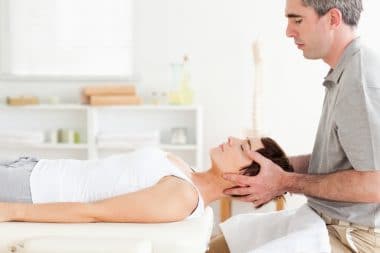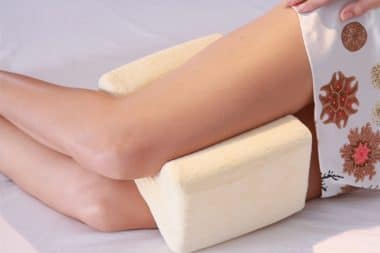Have you felt chronic pain in the outside of your knee? Or maybe you have hip pain. There are several possibilities and one is Iliotibial Band Syndrome, also called ITB.
Iliotibial band syndrome is a common sports injury that affects the knee of runners, bikers, hikers and weight lifters.
The Iliotibial Band is a tendonous extension of the fascia that covers from the lateral condyle of the tibia to the gluteus maximus; basically from the knee to the hip. The Iliotibial band provides support and stability and holds the pelvis to the lower leg.
Iliotibial band syndrome happens when the band becomes inflamed. This is commonly an overuse injury associated with runners, hikers, bikers and weight lifters. There are training habits that increase your risk of developing Iliotibial Band Syndrome. If you are a runner exercising on a banked surface, inadequate warm up or cool down, increasing distance too quickly, downhill running or running the stairs can increase your risk of developing Iliotibial Band Syndrome.
Other abnormalities in the biomechanical expression of the foot and leg can also increase your risk. These abnormalities include over pronation, uneven leg length or bowed legs can also cause undue stress on the iliotibial band that will lead to over use and inflammation.
Those athletes who suffer from iliotibial band syndrome will experience irritation of the band and pain when the knee is flexed and then extended. This motion makes running or hiking difficult and painful. The athlete is often unable to point to a specific area that is painful but rather will use his whole palm over the lateral aspect of the knee. Runners notice that pain becomes worse as they run downhill and others find that sitting for long periods with their knee flexed results in increased pain.
Diagnosis of iliotibial band syndrome is based on a thorough history and physical. Some patients may benefit from an MRI which will show a pocket of fluid which is a result of the chronic irritation and inflammation under the lateral epicondyle, just over the outer knee.
Treatment of iliotibial band syndrome is based on the severity of the condition and the ability of the athlete to comply with the recommendations for treatment and rehabilitation. When the athlete is able to complete rehabilitation and correct the reason for developing the condition in the first place then the likelihood of developing the problem again goes down significantly.
Your physician will recommend rest, which means you stop the athletic activity which caused the issue. You will want to ice the area several times a day and as the pain decreases you will be shown sports massage to decrease the adhesions that can develop in tendons when inflammation has been present.
Low mileage recreational runners often respond well to anti-inflammatory medications, stretching, ice and rest. But competitive runners may need a more comprehensive approach to treatment. This can include corticosteroid injections if swelling continues to be noticed over the area 3 days after strict rest and anti-inflammatory medications have been started.
After the pain has been alleviated the athlete will begin stretching and strengthening the area to prevent this problem from happening again. The gluteus medius muscle is an important muscle to strengthen in this process.
Surgical treatment may be considered for those athletes in whom a more conservative approach hasn’t been successful. Surgical intervention is usually not necessary when the athlete recognizes the pain as a signal they should rest the area and treat it. An early diagnosis and treatment increases the probability that athlete will respond well to anti-inflammatory medications, rest, ice, stretching and strengthening.
Diagnosis
Iliotibial band syndrome is often called runners knee and is a common source of knee pain in runners, weight lifters and bikers. This syndrome is the leading cause of lateral knee pain in runners because they participate in more activities that are risk factors for the condition.
The iliotibial band is a thick tissue on the outside of the thigh that runs from the hip to the knee and inserting on the bone just below the knee. This band of tissue is crucial to the stability of the knee during any activity that requires the extension and flexion of the knee. The band continually rubs over the lateral femoral epicondyle, which is a bony protuberance on the knee. This, combined with the repeated flexion and extension during running or biking, can cause the area to become inflamed.
When the iliotibial band is inflamed it causes pain in the outside of the knee or the side of the hip. It can also be associated with weight lifting — doing squats — court sports, and even pregnancy. Doctors have identified several risk factors to developing this condition. These factors include a leg length discrepancy — meaning one leg is longer than the other — running on a banked surface, poor foot structure, shoe breakdown, increased intensity and muscle imbalances. Because of the variety of reasons that increase the risk factors for this condition the treatment and rehabilitation must be individualized.
People who are experiencing pain from iliotibial band syndrome will complain of pain in the knee when they are climbing stairs, running, or other repeated flexion and extension motion that is localized over the lateral aspect of the knee (outside of the knee). The pain is initially alleviated by rest and worsens if the person continues to exercise.
Doctors use a thorough medical history and physical to diagnose the problems with iliotibial band syndrome and differentiate the different types of physical therapy or changes to exercise routines that will be necessary to affect a complete recovery from the condition. During the medical history the physician will be interested in the type of pain, duration and amount; when the pain started, what type of exercise program is being used, if there have been any changes to intensity or area used, and the condition of the equipment, such as shoes, that are being used.
During the physical examination portion the doctor should be able to see the action of knee and hip, feel for swelling, heat or tenderness over the area, and evaluate your strength and pain with certain activities. Pain is often elicited in the office by asking the patient to do squats. The pain can move from the knee to the hip but it is more commonly felt in the knee.
During a physical examination the doctor can also determine how tight the ITB is. A tight ITB is one of the risk factors for developing the condition of iliotibial band syndrome.
There are no imaging studies that give physicians the ability to view the iliotibial band and diagnose the condition. The majority, if not all, of the diagnosis is based on an exhaustive physical examination and history that determines the reasons why the condition exists in the first place. Iliotibial band syndrome, although relatively common, is also easily diagnosed and treated. With proper treatment and changes to their program most runners and bikers are back to their sports in a matter of a couple of weeks.
Treatment and Recovery
Factors that increase the risk of developing iliotibial band syndrome are running shoes that are worn out, a sudden increase in downhill running, increased intensity of running schedule, running on the same side of the road on in the same direction on the track, leg length discrepancy, leg strength discrepancy and biomechanical foot problems.
Initial treatment of iliotibial band syndrome are the same things done for most every muscle or tendon injury — stop the activity, use RICE, anti-inflammatory medications and physician appointment. Count on not running for about a month after the pain has begun. You may not be happy about not running but complete recovery is very important for any long term activity level. Don’t jeopardize the ability to ride bikes and run in 1 year by pushing through the pain today.
RICE is Rest, Ice, Compression and Elevation. Rest the muscle — don’t use the stairs but take the elevator, stop the activity. Use an ice cup to massage the area and decrease the swelling. Using a Styrofoam cup fill it with water and freeze it. When you are massaging the ice over the area you’ll find it melts quickly so keep a towel handy. As the ice melts you can peel the cup down. Do this 3 times a day for 20 minutes.
Speak with your physician about which anti-inflammatory medications that you can use with your other medical conditions or medications. Ibuprofen is one that is over the counter and usually well tolerated. Your doctor may have other options available to you that are prescription strength if ibuprofen will interact with other medications you may be taking.
The next step in the treatment and recovery of iliotibial band syndrome is to determine the causative factor or factors to improve the chances of a complete recovery. Look for running shoes that are worn on the outside of the heel. If the running program changed drastically recently and there are no other risk factors then when the pain goes and you are comfortable go back to your running routine at a much easier pace without downhill running and rotating the direction on the track that you’re running. Iliotibial band syndrome is also common in road runners who have been running on the same side of the road. The ITB will be most common on the leg closest to the curb. Because the slope of the road the curb leg will always be hitting the road lower than the leg closer to the road. This creates uneven stresses on the body and the iliotibial band will most likely become inflamed.
Another common cause of iliotibial band syndrome is biomechanical imbalances in the foot. If there are no other causes identified the next step is a visit to a sports podiatrist who can evaluate the way the foot strikes the ground on impact and with push off to determine if biomechanical issues are causing long-term problems with the feet and legs.
Once the causes have been determined and changed it’s time to start stretching and strengthening. Another major cause of most overuse injuries is either inappropriate use of the joint or lack of strength and flexibility. The muscles most needing strengthening is the inner most quadriceps muscle. The three outermost muscles are most worked and strong. The inner most muscle is often the most neglected and because this causes an imbalance in the muscle structures it also places the leg at greater risk for injury.
Stretching the iliotibial band is another factor in the treatment of iliotibial band syndrome. Even if it was not tight before an injury, inflammation and swelling will cause the fibrous tissue to tighten. Stretching will help to reduce the risk of recurrence of the injury.
To strengthen the inner quadriceps muscle sit on the floor with your back supported against a wall. Watch out for your back because as your muscle fatigues your body will attempt to use the back muscles to compensate. This will only make your back sore and do nothing for your leg. Do the exercise on both sides but for ease of explanation this is for the left leg.
With your back against the wall, bend your right knee and hug it to your chest. The left leg is straight, toes flexed toward the head. Now turn the left leg outward so the toes point to the left as far as you can. Do leg raises from this position until the leg begins to fatigue. You may be able to start with 10 or 20. Once the leg is tired switch to the other leg and then back again. Do 2 or 3 sets on each leg, making note of how many you can do and attempting to increase the repetitions each week. Do this exercise 5 times each week. It may be boring but it will help to stabilize the knee, decrease the pain, and improve the running form.
An iliotibial band stretch is accomplished by standing with one side to a wall. This stretch is done on both legs, injured and the non-injured leg. For ease of explanation it will be the right leg that is stretched. The right side of your body is facing the wall, and hand on the wall for support. The left leg crosses over the front of the right leg toward the wall. Now lean in toward the wall with the right leg straight and stretching the outside of the right leg from hip to knee.
Hold the stretch for 20 seconds. Do 5 on each side, alternating sides.
Iliotibial band syndrome is a sports injury that is common to runners, bikers and some weight lifters. Although athletes will find themselves sidelined from their sport for at least a month to achieve full recovery, the results will be well worth it. Improved flexibility and strength in the legs will help to improve the function and performance at the sport.







Reply